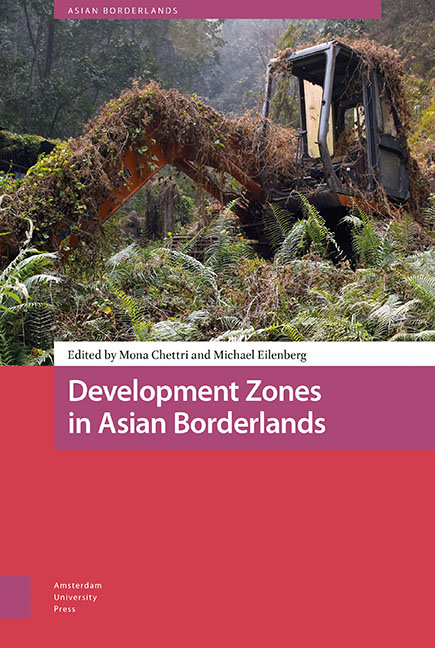Book contents
- Frontmatter
- Contents
- List of Figures and Tables
- Acknowledgements
- Introduction: Enclave Development and Socio-spatial Transformations in Asian Borderlands
- 1 Post-disaster Development Zones and Dry Ports as Geopolitical Infrastructures in Nepal
- 2 Onwards and Upwards: Aerial Development Zones in Nepal
- 3 Casinos as Special Zones: Speculative Development on the Nation’s Edge
- 4 Thinking the Zone: Development, Climate, and Heterodystopia
- 5 From Shangri-La to De facto SEZ: Land Grabs from “Below” in Sikkim, India
- 6 Development Zones in Conflict-Affected Borderlands: The Case of Muse, Northern Shan State, Myanmar
- 7 Smart Enclaves in the Borderland: Digital Obligations in Northeast India
- 8 Post-Disaster Economies at the Margins: Development, Profit, and Insecurities Across Nepal’s Northern Borderlands
- 9 Development from the Margins: Failing Zones and Suspended Development in an Indonesian Border Village
- 10 From Boom to Bust – to Boom Again?: Infrastructural Suspension and the Making of a Development Zone at the China-Laos Borderlands
- 11 Genealogies of Extraction: De Facto Development Zones in the Indonesian Borderlands
- Notes on Contributors
- Index
2 - Onwards and Upwards: Aerial Development Zones in Nepal
Published online by Cambridge University Press: 18 June 2021
- Frontmatter
- Contents
- List of Figures and Tables
- Acknowledgements
- Introduction: Enclave Development and Socio-spatial Transformations in Asian Borderlands
- 1 Post-disaster Development Zones and Dry Ports as Geopolitical Infrastructures in Nepal
- 2 Onwards and Upwards: Aerial Development Zones in Nepal
- 3 Casinos as Special Zones: Speculative Development on the Nation’s Edge
- 4 Thinking the Zone: Development, Climate, and Heterodystopia
- 5 From Shangri-La to De facto SEZ: Land Grabs from “Below” in Sikkim, India
- 6 Development Zones in Conflict-Affected Borderlands: The Case of Muse, Northern Shan State, Myanmar
- 7 Smart Enclaves in the Borderland: Digital Obligations in Northeast India
- 8 Post-Disaster Economies at the Margins: Development, Profit, and Insecurities Across Nepal’s Northern Borderlands
- 9 Development from the Margins: Failing Zones and Suspended Development in an Indonesian Border Village
- 10 From Boom to Bust – to Boom Again?: Infrastructural Suspension and the Making of a Development Zone at the China-Laos Borderlands
- 11 Genealogies of Extraction: De Facto Development Zones in the Indonesian Borderlands
- Notes on Contributors
- Index
Summary
Abstract
This chapter explores how airports and airspace can be recognised as development zones that serve to connect the ground and the air. Through four “aerial snapshots” (airspace restrictions, a new air route, a binational airline venture, and the building of the “next” international airport in Nepal), this paper shows how aerial development takes on a specific significance in how Nepal positions itself vis-à-vis the borders of India and China. It argues that a volumetric approach – paying attention to the spatial production of both land and air – is vital in order to understand the future shape of aerial development zones in the Himalayas.
Keywords: aeromobility, airspace, aviation, volume, Himalayas, Nepal
“We are a landlocked country. Think about Swiss airspace for instance. Hundreds of entry points! In Nepal, there is only one. […] Well, there are three entry points. China from the north and the Bhutan one. The rest [from India] is so congested!”
– A Nepali Air Traffic Controller, 2018Introduction: The Ground and the Air
On any given day, there are hundreds of aircraft taking off from the single runway at Tribhuvan International Airport in Kathmandu, currently Nepal’s only international airport. As a reflection of the massive global increase in air travel – worldwide air passengers are expected to double to 7.8 billion over the next couple of decades – Nepal is experiencing severe congestion in the skies and capacity issues at its main airport. Air travel is still creeping upwards: labour migrants travel from rural villages to build infrastructures in the Gulf States, while the roads in their own towns are in disrepair. The airport at Kathmandu is nearing full capacity, while airline carriers are planning to add new flight routes, even as there is growing pressure from environmental activists to curb airport construction. Given the significant increase in air travel both to and from Nepal, aviation officials spend much of their time attempting to solve congestion problems in order to keep traffic moving smoothly.
One of the ways to make sure that aircraft can fit in the sky and on the ground is by stretching (air)space and time in various ways in order to alleviate or “fix” air traffic congestion.
- Type
- Chapter
- Information
- Development Zones in Asian Borderlands , pp. 55 - 72Publisher: Amsterdam University PressPrint publication year: 2021



